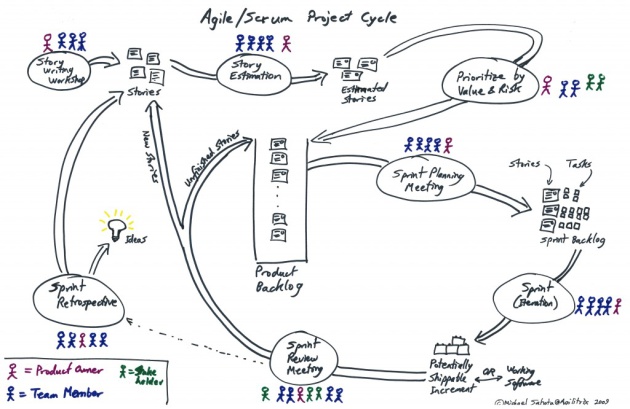
Program Overview: TWO Days Training and Coaching Workshop
It is designed especially for Business Analysts, Product Managers, and Product Owners and for those who want to grow to Agile Product Owner role or for Senior Management who want to implement Agile Product Ownership in their Organization. Participants can maximize the benefit they receive from their Agile projects by learning how to better prfioritize and interface with Agile teams. The high level learning goals of this Workshop are:
Outcome of this workshop:
- How to best fulfill your role as Product Owner(PO) towards a Scrum team
- How to effectively create, groom, and prioritize the Product Backlog
- How to do Sprint Planing and Release planning using story mapping
- How to create a personas, user stories to conceptualize the product
- Role of PO in Sprints and sprint meetings
- Applying key Agile Management practices to improve effectiveness of business solution and of Agile teams
- Using Agile estimation and release planning by pointstechnique to better forecast their work
- How to structure your teams to facilitate collaboration, and self-organization to maximize business value to the clients
- Using Agile empirical metrics to measure progress and quality
- How to be effective PO in distributed agile teams and address communication, trust, and quality issues
Format of Workshop:
Participants get to understand core principles and in-depth Agile/Scrum framework in the form of videos, group discussions, exercises, interactive sessions, innovation games. Facilitator will address all the questions from participants about applying Scrum on real life projects.
Following topics in detail will be addressed in 2 days:
- Why and What is Agile
- Industry facts about failures and need for Agile
- Agile Values and Principles
- Agile vs Traditional Approach
- Business outcome and stats of using Agile
- Lean Innovation game – Batch vs Flow
- Scrum framework in detail
- Scrum Roles(Product Owner,ScrumMaster and Team)
- Scrum Ceremonies and artifacts
- How to prepare for Sprint planning, pre-planning
- Velocity and Commitment driven planning techniques
- Role of PO in Sprint planning, daily stand-up, demo and retrospectives
- Role of PO in backlog grooming and making it effective
- Product Ownership and Personas
- Crafting product vision
- Facets of customer needs
- Identifying and modeling users
- Personifying for a business case with example
- Different PO Success modes
- Overcoming 6 common problems of PO
- User Stories
- What Is/Not a User Story and 3C/INVEST model
- Functional and Non-Functional Stories
- How to validate requirements using acceptance criteria
- Writing acceptance criteria with examples
- Who and When to write stories with tips
- Applying story splitting patterns to break stories
- Exercise on Story writing
- Agile Estimation and Planning
- Using sizing technique for estimation and planning
- Story Point Estimation and How to do it using planning poker
- How to use sizing/velocity for release planning
- Calculating capacity using focus factor and using it for sprint planning
- Progress Tracking using Agile Metrics
- How to create and use Burn-down charts
- Different charts and metrics effectiveness and its different usages
- How to use story wall to find project progress
- Using Release burn-down and story acceptance charts
- Backlog Prioritization and Release planning
- How to make your product backlog DEEP
- Prioritization using themes
- Prioritization using desirability
- Converting Flat backlog to hierarchical backlog with sequencing, dependency and with perceived business value prioritization
- Release planning using Story Mapping technique
- Using story thinning parameters
- Exercise: Solving a business case by creating personas, user stories and then using story mapping to create a release roadmap
- Scaling Scrum
- Effective scaling strategies for teams/organization
- Different distributed agile models to apply across different geographies and how to make product ownership effective on distributed scrums
Explore the site and our blog http://www.agilebuddha.com, and get to know us. Then, if you think I might be right for your organization, contact us. We would love to help you get started or get better with agile.